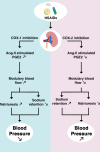Kidney damage from nonsteroidal anti-inflammatory drugs-Myth or truth? Review of selected literature
- PMID: 34310861
- PMCID: PMC8313037
- DOI: 10.1002/prp2.817
Kidney damage from nonsteroidal anti-inflammatory drugs-Myth or truth? Review of selected literature
Abstract
Nonsteroidal anti-inflammatory drugs (NSAIDs) are widely available drugs with anti-inflammatory and analgesic properties. Their mechanism of action is associated with the enzymes of the arachidonic acid cycle (cyclooxygenases: COX-1 and COX-2). The cyclooxygenase pathway results in the formation of prostanoids (prostaglandins [PGs], prostacyclins, and thromboxanes). It affects various structures of the human body, including the kidneys. Medical literature associates the usage of NSAIDs with acute kidney injury (AKI), tubulointerstitial nephritis (TIN), as well as nephrotic syndrome and chronic kidney disease (CKD). AKI associated with the chronic consumption of NSAIDs is mainly attributed to pharmacological polytherapy and the presence of cardiovascular or hepatic comorbidities. The pathomechanism of AKI and CKD is associated with inhibition of the biosynthesis of prostanoids involved in the maintenance of renal blood flow, especially PGE2 and PGI2. It is suggested that both COX isoforms play opposing roles in renal function, with natriuresis increased by COX-1 inhibition followed by a drop in a blood pressure, whereas COX-2 inhibition increases blood pressure and promotes sodium retention. TIN after NSAID use is potentially associated with glomerular basement membrane damage, reduction in pore size, and podocyte density. Therefore, nephrotic proteinuria and impairment of renal function may occur. The following article analyzes the association of NSAIDs with kidney disease based on available medical literature.
Keywords: AKI; CKD; NSAIDs; nephrotoxicity.
© 2021 The Authors. Pharmacology Research & Perspectives published by British Pharmacological Society and American Society for Pharmacology and Experimental Therapeutics and John Wiley & Sons Ltd.
Conflict of interest statement
The authors declare no conflict of interest.
Figures



References
-
- Friedewald VE, Bennett JS, Christo JP, et al. AJC Editor’s consensus: selective and nonselective nonsteroidal anti‐inflammatory drugs and cardiovascular risk. Am J Cardiol. 2010;106:873‐884. - PubMed
-
- Samborski W, Filipiak KJ, Kaczmarczyk J, Tykarski A. Niesteroidowe leki przeciwzapalne a powikłania sercowo‐naczyniowe i gastroenterologiczne—algorytm wyboru. Chor Serca i Naczyń. 2016;13:257‐264.
-
- Antman EM, Bennett JS, Daugherty A, et al. Use of nonsteroidal antiinflammatory drugs: an update for clinicians: a scientific statement from the American Heart Association. Circulation. 2007;115:1634‐1642. - PubMed
Publication types
MeSH terms
Substances
LinkOut - more resources
Full Text Sources
Medical
Research Materials

